| Day | Activity | Overnight Stay |
|---|---|---|
| 0 | Arrive in Toyko | Tokyo |
| 1 | Tokyo - Chiyoda, Taitō | Tokyo |
| 2 | Tokyo - Minato, Shinjuku, Shibuya | Tokyo |
| 3 | Tokyo - Indoor Day | Tokyo |
| 4 | Shinkansen Train to Kyoto | Kyoto |
| 5 | Himeji & Kobe | Kyoto |
| 6 | Nara & Osaka | Kyoto |
| 7 | Mount Kurama, Fushimi Inari | Kyoto |
| 8 | Kyoto - Kiyomizu-dera | Kyoto |
| 9 | Kyoto - Arashiyama | Kyoto |
| 10 | Bus to Takayama, city tour | Takayama |
| 11 | Shirakawa-go | Okuhida Onsengo |
| 12 | Shinhotaka Ropeway | Okuhida Onsengo |
| 13 | Matsumoto, Bus to Tokyo | Tokyo |
| 14 | Tokyo - Chūō | Tokyo |
| 15 | Morning flight back | Home |
Days 1-3: Tokyo
Welcome to the most populous city in the world! With close to 38 million inhabitants, the Tokyo Metropolitan Area is a huge urban center.
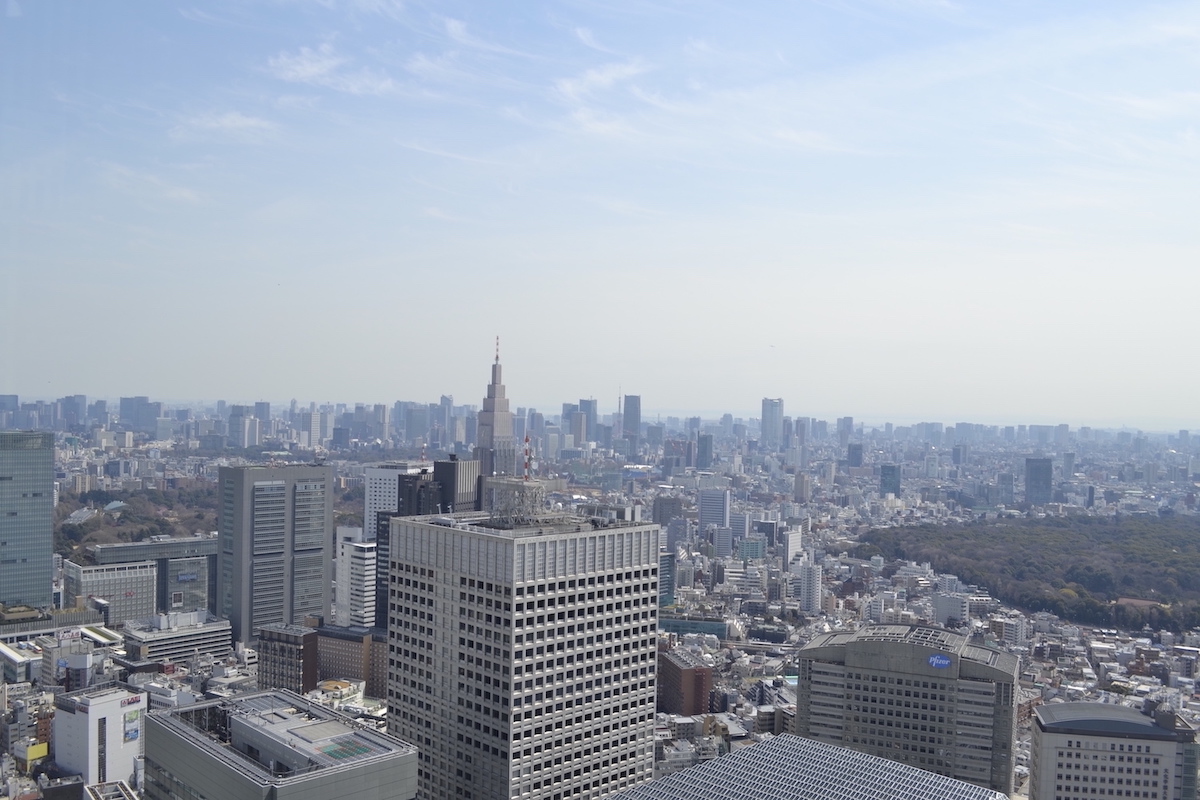
For moving around, we recommend the Tokyo Metro Pass, which is available only for visitors. It is quite cheap compared with individual tickets and will give you unlimited access to all subways. And while the system looks overwhelming at first, it is by far the most organized and well signaled system we ever used. Still, a mobile app of the system is helpful when planning your trip from A to B, because most likely you will have to change lines.
Fun fact, there is no city officially named Tokyo. The urban area was split into multiple cities, or wards. The most popular are the ones closest to the geographical center of the area: Chiyoda, Chūō, Minato, Taitō, Shinjuku and Shibuya.
Walking is an option and you will do a lot of it during your visit, but you will need public transportation to move from one ward to another.
With this in mind, we spent the first two days in Tokyo wandering around some of the most popular wards. And for our third day we used our backup plan for indoor activities as we had a rainy day.
Chiyoda
The heart of the city is built around the Imperial Palace, the main residence of the emperor of Japan. However, since the palace is not open for visitors and the area around is a financial district, you should not waste too much time around.
One interesting part in the north of Chiyoda you should definitely visit is Akihabara, famous for its maid cafes. While there, go check the Yodobashi electronic store with its seven levels and an incredible variety of products.
Taitō
Further north, Taitō is a more relaxed ward. Two of the most visited spots in Tokyo can be found here: Ueno Park and Sensō-ji temple.
We first went to Ueno, but before entering the park we stopped at a local market next to the train lines for some authentic street food. We definitely recommend this place, it's called Ameya Yokocho Market and it's the perfect introduction into urban Japan.
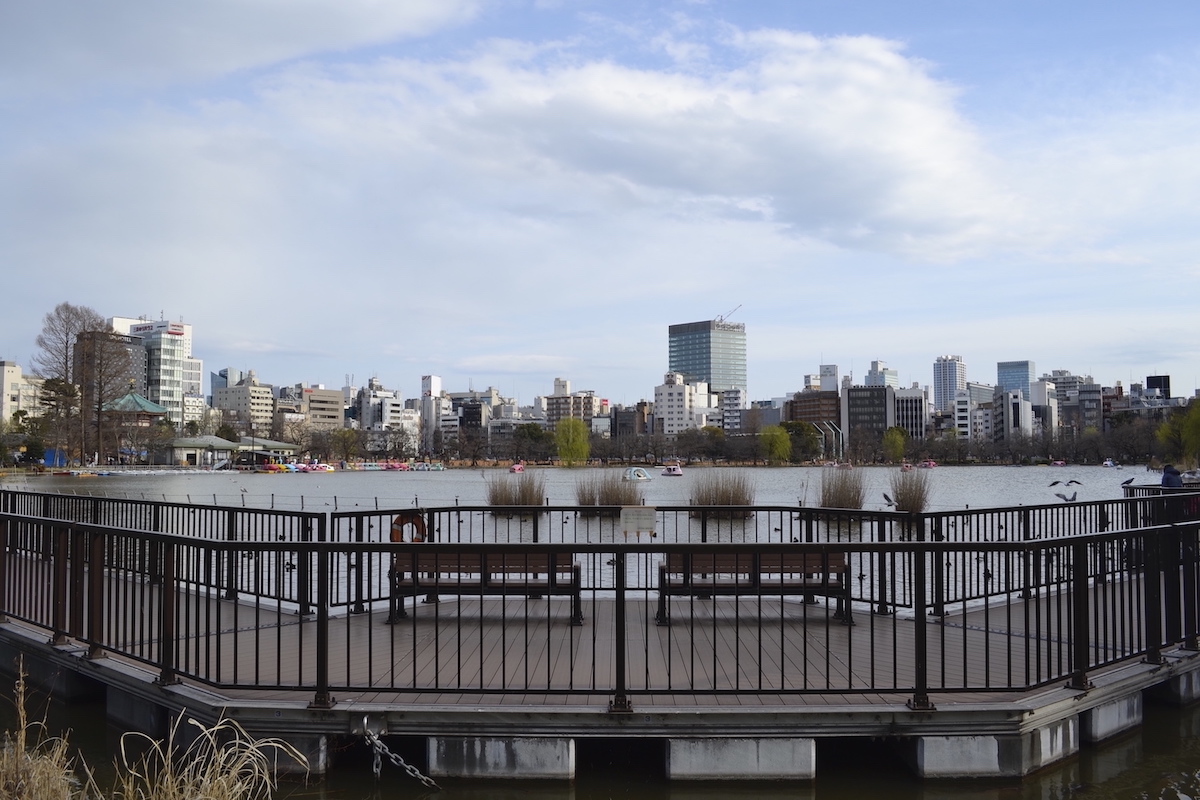
Then we did a quick tour of the park, one of the most popular in Tokyo during sakura. However, we were there a couple of days early and the cherries were not yet in full blossom. Nevertheless, it's a great spot that should definitely be on your map when visiting Tokyo.
In the second part of the day, we visited one of the oldest neighbourhoods of Tokyo, Asakusa. It is built around the ancient Buddhist temple of Sensō-ji, the oldest one in Tokyo. Great restaurants in the area as well!
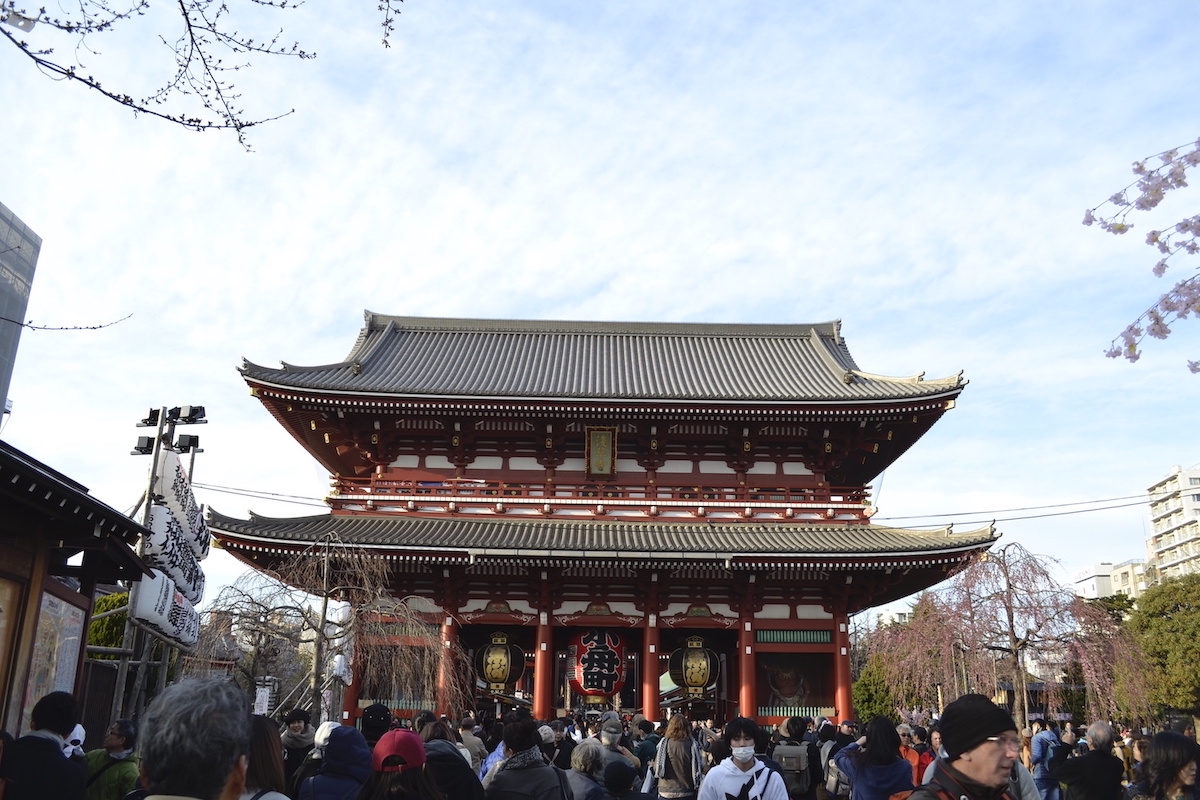
Not far from Asakusa, you can visit Tokyo Skytree, which at 634m is the second tallest structure in the world after Burj Khalifa. But be prepared for a hefty ticket price. When we were there in 2017 it was about 20 USD.
Minato
Next day we started with a short walk in Minato, a big ward situated in the southern part of the city. Minato is famous for Tokyo Tower, a landmark structure that resembles the Eiffel Tower and offers panoramic views of the city. It is not as spectacular as the Eiffel Tower, but the red-white color scheme is beautiful and the tower is nicely floodlighted in the evenings. Going to the top is not that expensive, at around 8 USD, but we skipped it as we had a recommendation for another viewpoint.
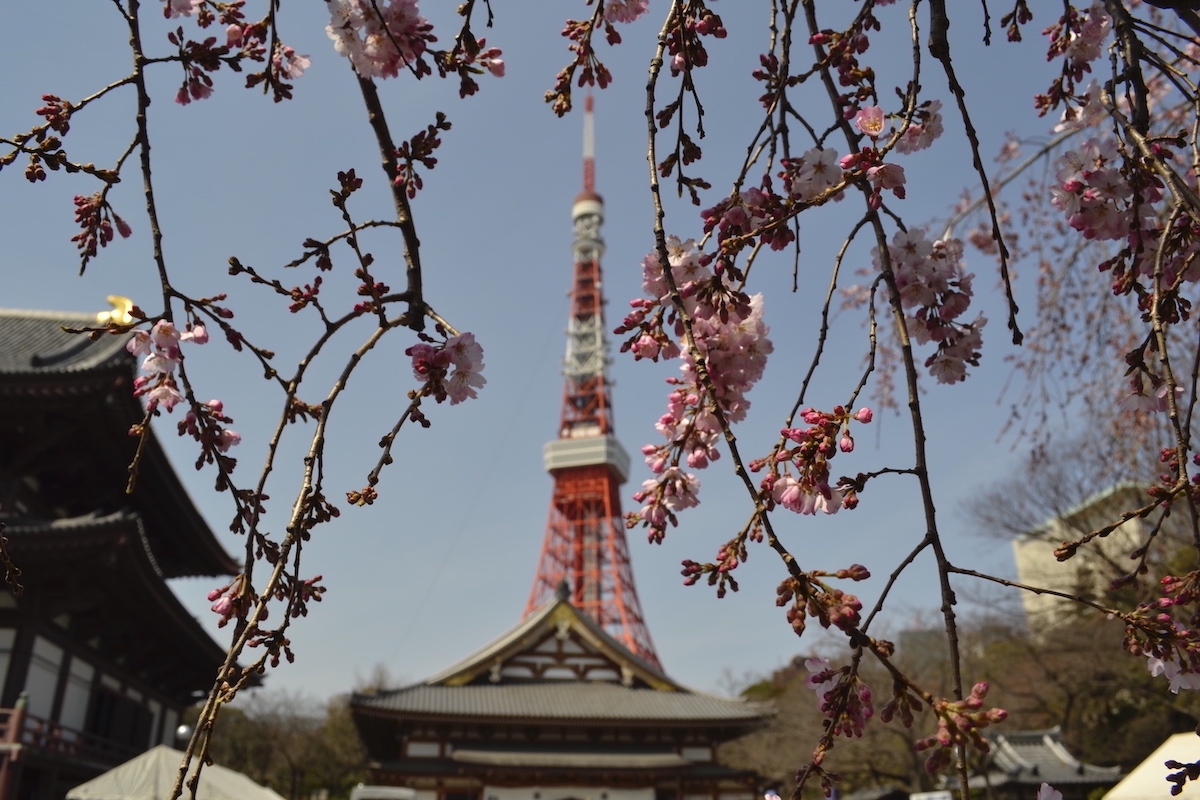
Close to the tower, we stopped by the Zojoji Temple, a Buddhist temple from the 17th century.
Minato also features some very modern areas like Roppongi and Shiodome. These neighbourhoods are full of office towers and high end residential buildings.
Shinjuku
A visit to Tokyo is not complete without spending a few hours in Shinjuku. For us, it felt like this is the heart of the city, especially during the evenings and late nights when the clubs and karaoke bars open.
But there's more. Shinjuku is also a major train and bus hub and the economic and political center of the Tokyo Metropolitan Area. Speaking of that, the Tokyo Metropolitan Government building, or Tocho as the Japanese call it, offers 360 views of the entire city. There are two towers and each have an elevator to the 55th floor. The best part? it's free and one of them is open until 10pm if you like the night views. We highly recommend it!
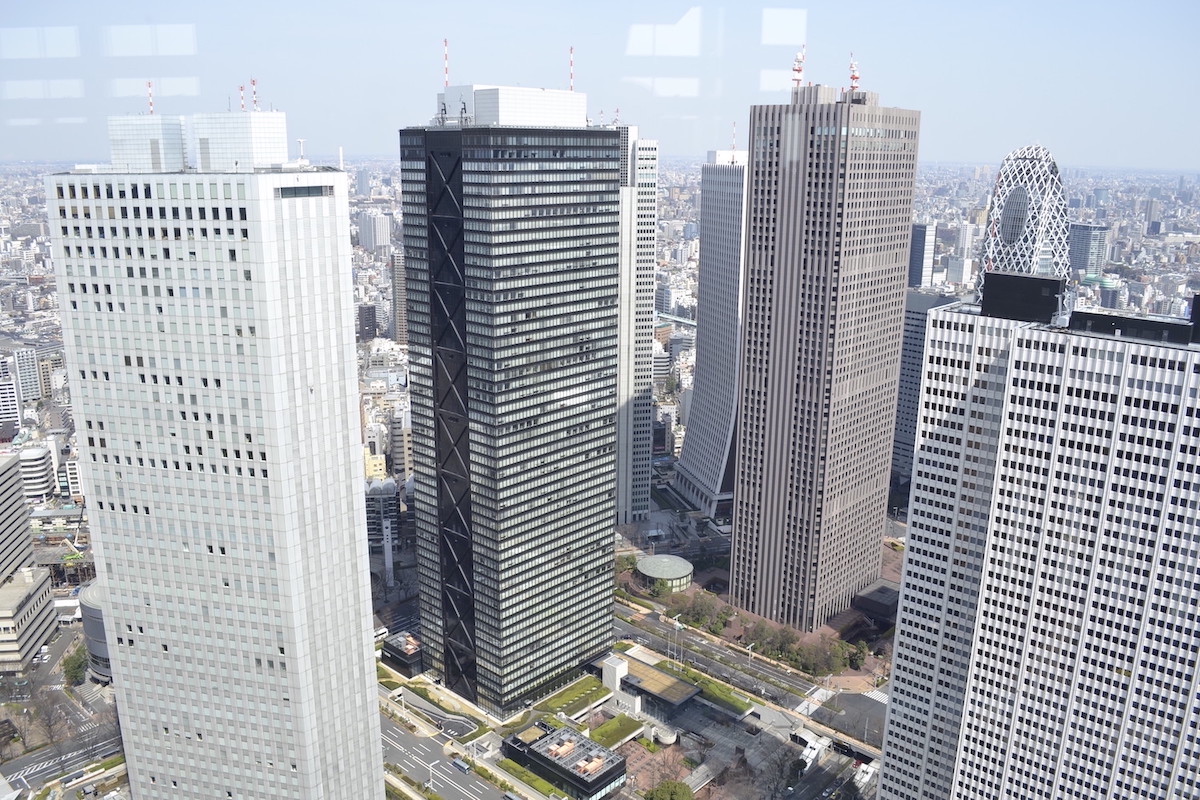
Fun fact. From the towers, you get a direct view to the Park Hyatt Hotel, which was the setting of Lost in Translation. By the way, that's a great movie to watch before visiting Japan for the first time. Even if it's not directly about Japan, you get some nice insights on the Japanese culture.
After seeing the panoramic sights of the city, we decided to take a walk through the busy streets below us. Shinjuku is one of the many places in Japan where it's just fun to walk and observe the people. Watch their habits and absorb the unique culture of the country.
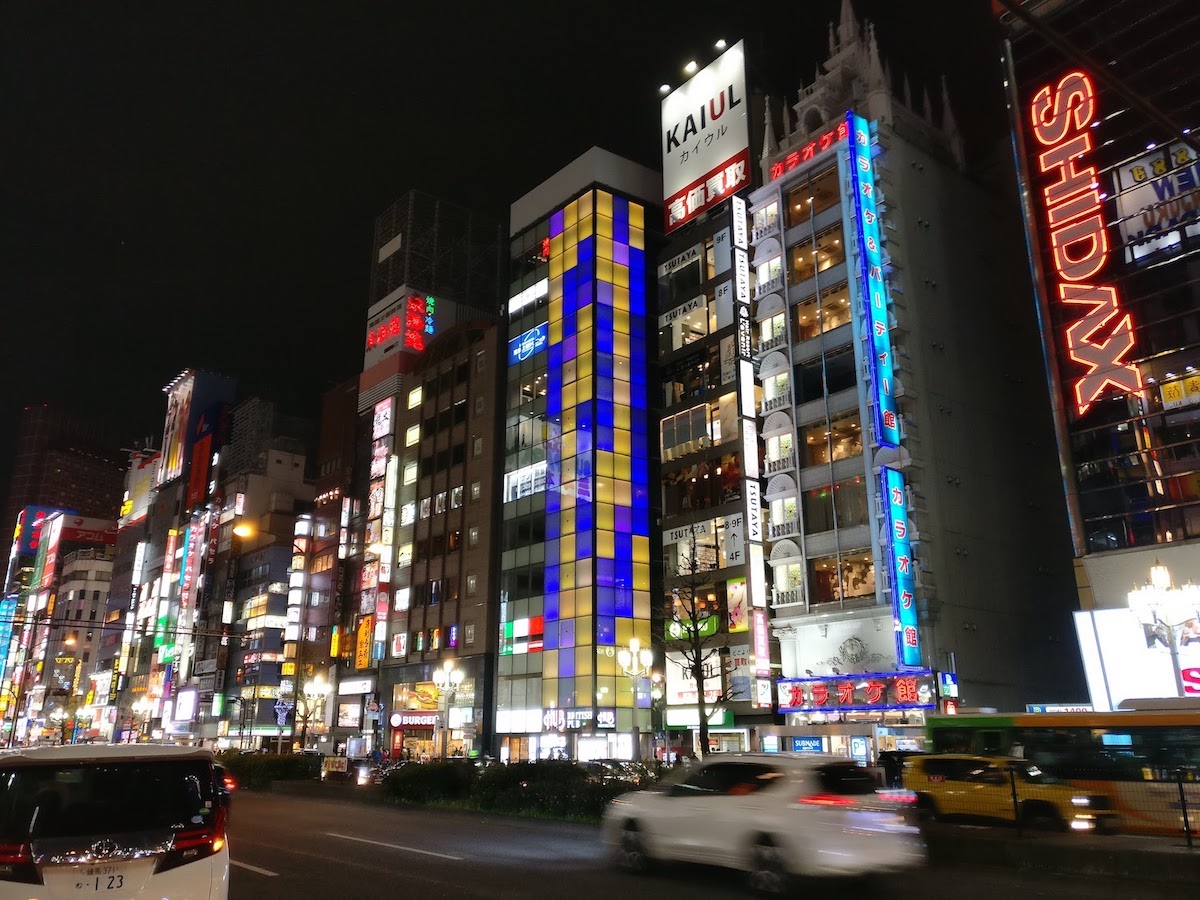
Make sure you take a quick tour of a Pachinko parlor, it's incredibly loud and chaotic. Also in Shinjuku, stop by the giant Godzilla head on top of the Toho building, owned by the company that created the original movies.
We ended our tour in Shinjuku Gyoen National Garden. We haven't been to New York yet, but people say this is the closest thing you get to Central Park. The park was probably our favorite relaxation spot during the trip. It is one of the biggest parks in Tokyo, it has a lot of beautiful gardens in different international styles and a lot of open areas.
There's a small entrance fee, but that is perfect as it ensures the place is never too crowded, not even during sakura.
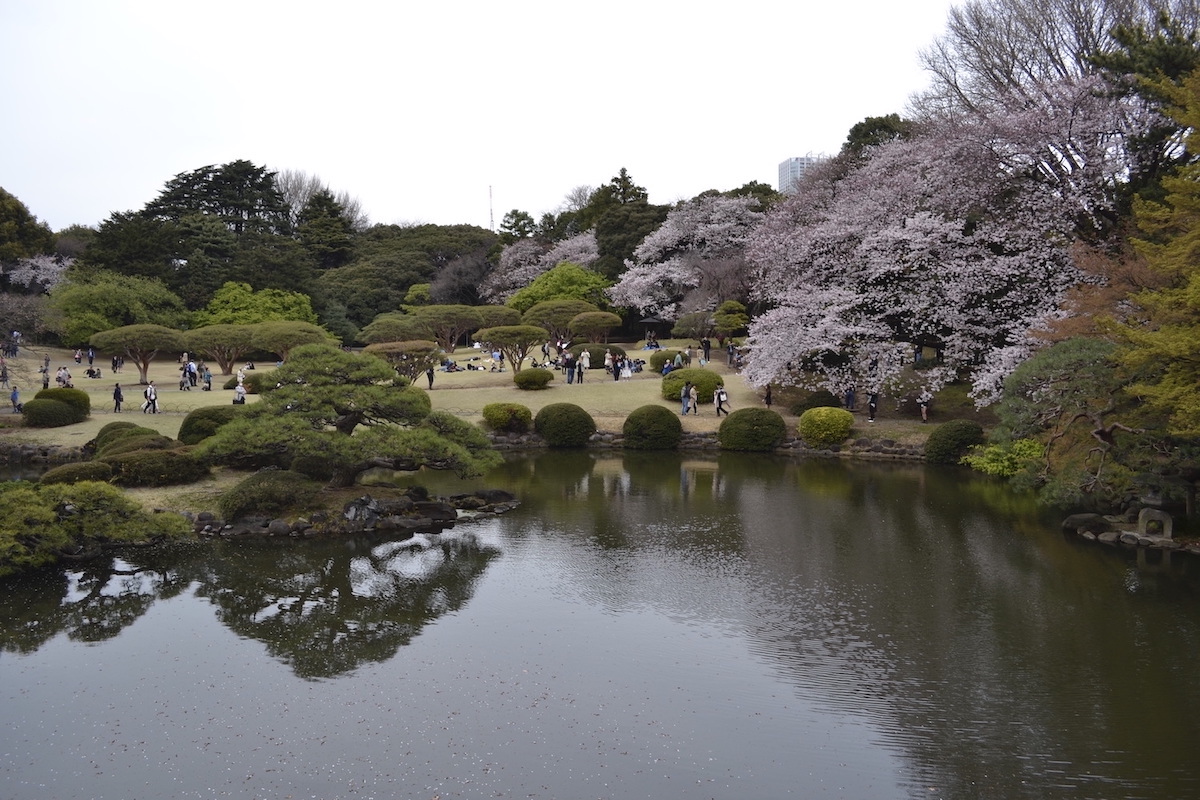
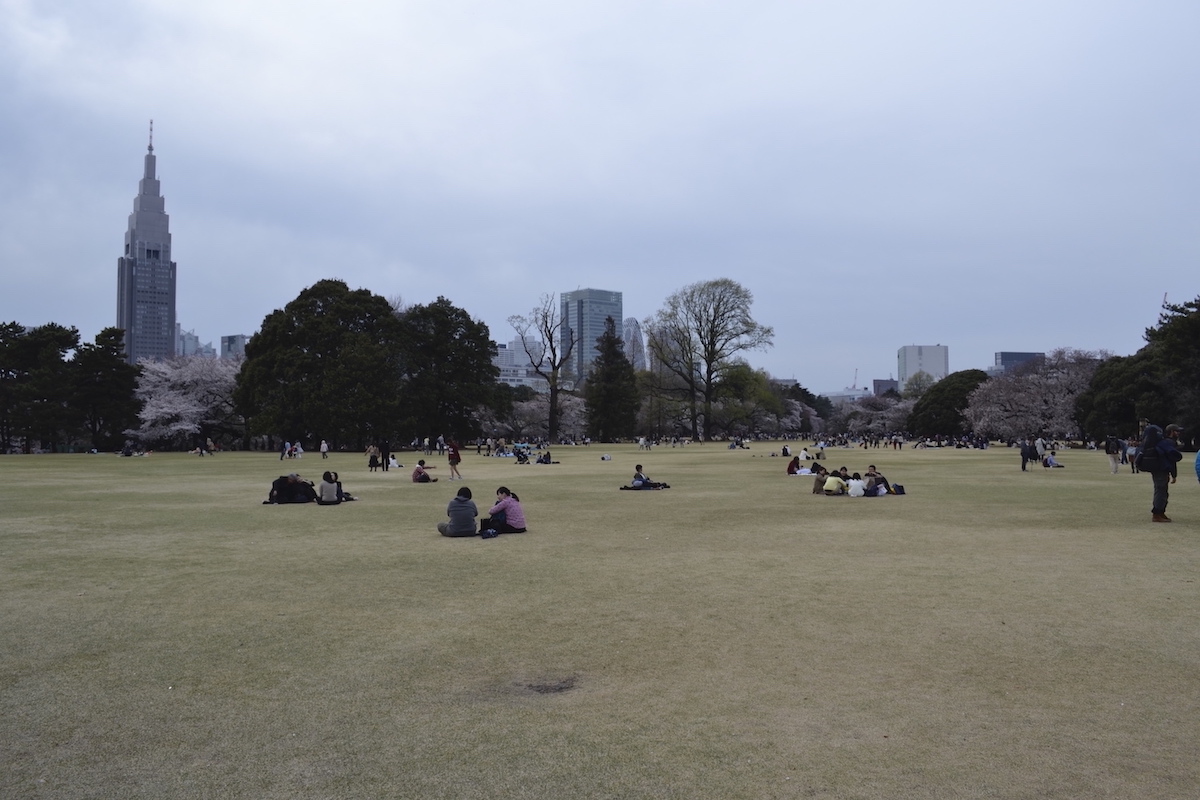
Shibuya
Further south lies Shibuya, another ward not to be missed while in Tokyo. We walked from Shinjuku Gyoen to another green area, split in two between the Shinto shrine of Meiji Jingu and Yoyogi Park. The latter is usually packed with young people and families practicing various outdoor sports.
We then continued our walk towards the famous Shibuya crossing. And yes, we walked a lot during that day! The center of Shibuya is another bustling area, packed with restaurants and shopping centers. And then you get to the crossing, considered the world's busiest pedestrian crossing, with an estimate of 2500 people crossing at a time. After crossing a couple of times, because why not? we went to a shopping center and took this video from above:
Yep, that's life in Tokyo. We finished the day in the Japanese style, hitting an Izakaya pub in Shibuya.
Koto
The third day - wow, it's been only two days since we arrived - was rather ugly, with constant rain and fog, so we decided to spend it indoor. Luckily, Tokyo has your back in these situations. Museum fans should definitely check out Miraikan, or the National Museum of Emerging Science and Innovation. They offer incredible exhibitions, great educational materials and a chance to see Asimo in action.
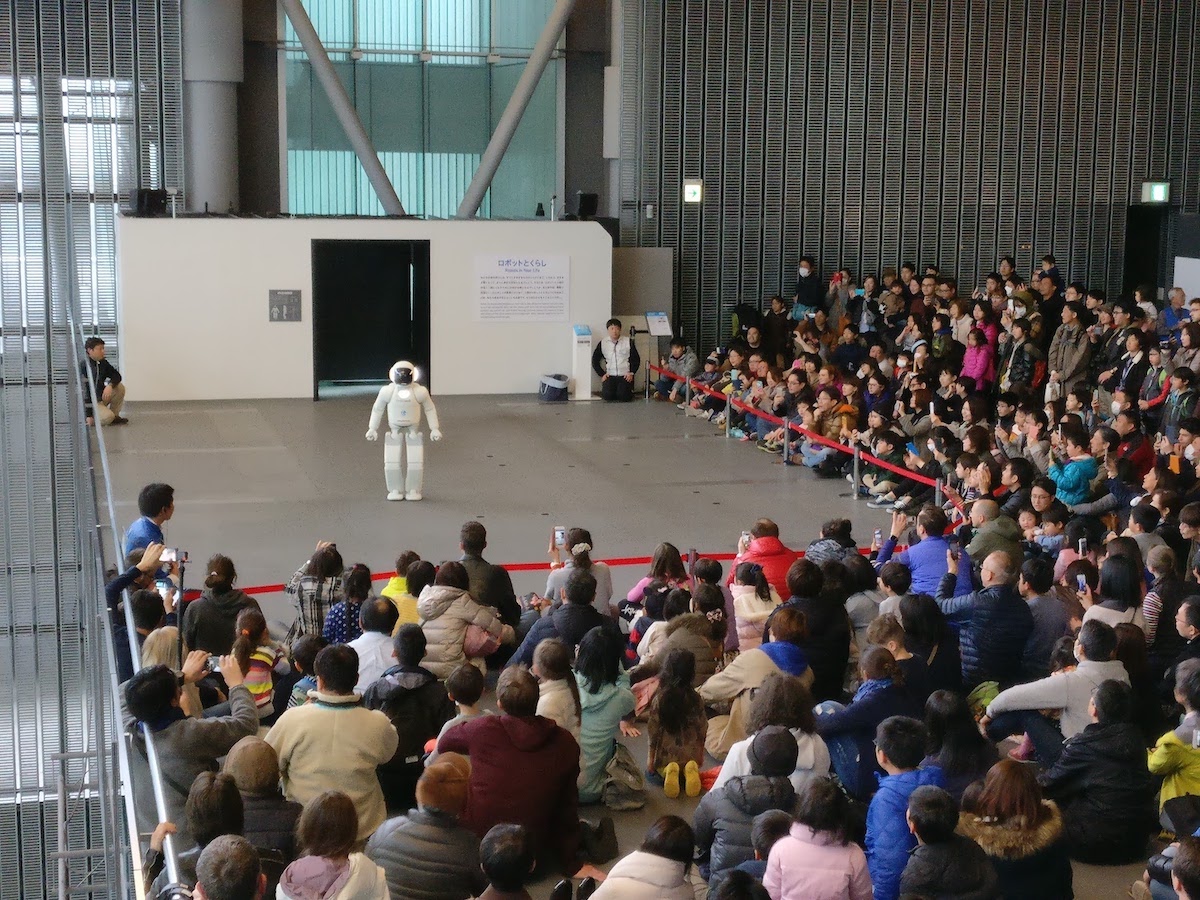
The museum is located on an island in another district, called Koto, a bit farther from central Tokyo, in the harbor area. To get there, you can hop on an automated light rail transit service called Yurikamome.
The island also houses a few big shopping malls so we spent some time in there. Later, we also found a Toyota museum nearby, which was fun.
Days 4-9: Kansai Area
The second leg of our journey began with a 2 hour 40 minutes train ride with the Shinkansen, the Japanese bullet-train. We took the train from Tokyo to Kyoto, the old capital of Japan. The ride covered over 500km in that time span, it's quite an experience. Keep in mind that trains are pretty expensive in Japan, so be ready to pay over 100 EUR for a long distance ticket. A cheaper alternative, if you don't care that much about the travel time is to use buses.
The area around Kyoto and Osaka is called Kansai and is one of the most visited regions of Japan.
Local trains within the region are incredibly convenient. We stayed for six nights in a smaller town, about half-way between Osaka and Kyoto and we were always 25 to 35 minutes away from the two city centers.
Speaking of staying overnight, we had a great experience at Kyoto Guest Inn Nagaokakyo. The owners are super kind and will help you out with anything you need during your stay. They speak fluent English and love explaining the cultural differences between Japan and the rest of the world. And believe us, there are a lot of them!
Himeji & Kobe
For the first day, we decided to visit Himeji, the western-most destination in Kansai. The city is famous for the Himeji Castle, one of the most visited sights in the entire country.
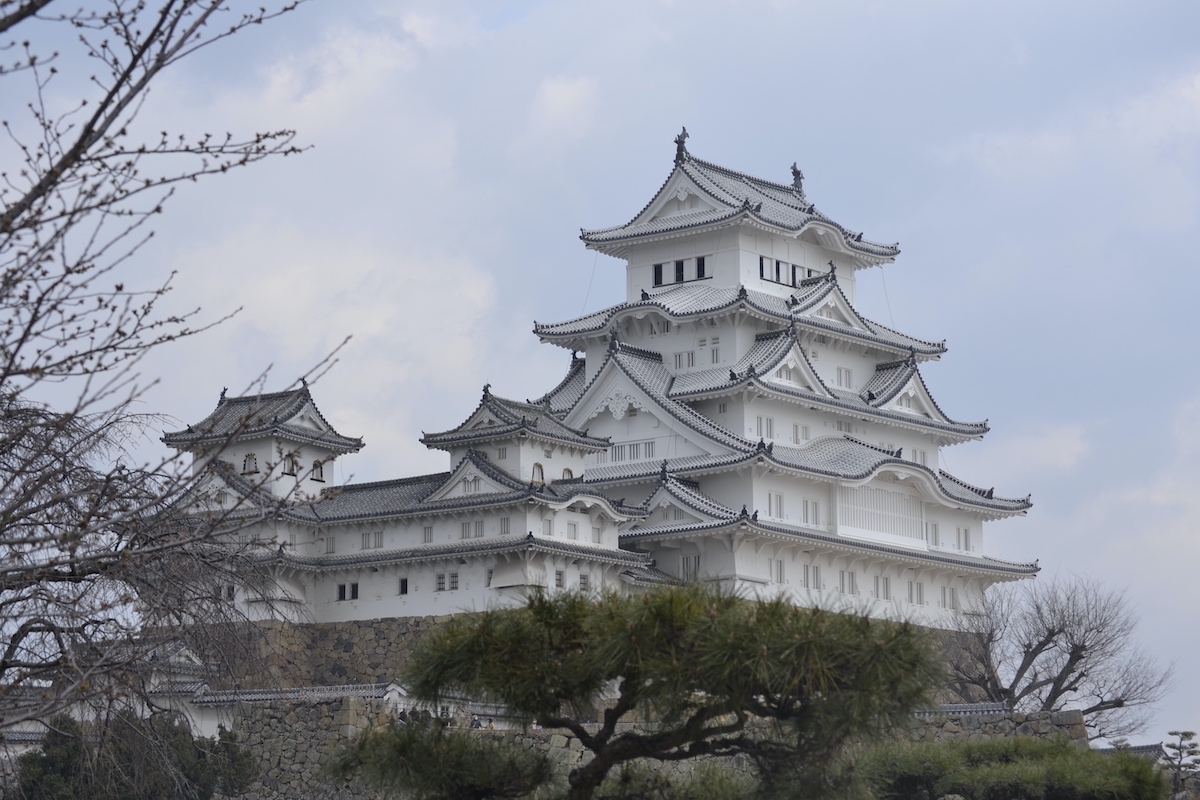
You can visit the courtyard and the castle itself, all the way to the top floor. Quite an interesting experience. But keep in mind that it is a very popular destination, so expect to see a lot of people during the visit.
On the way back from Himeji, we stopped at the Akashi Kaikyo Bridge. This is the longest suspension bridge in the world, connecting the main islands Honshu and Shikoku.

And since we were in the area, we finished the day in Kobe. We stopped there to enjoy the world famous Kobe beef at one of the steakhouses in the city and we strolled around the port area.
Kobe, Osaka and the surrounding cities form one of the biggest metropolitan areas in the country, with over 20 million inhabitants.
Nara & Osaka
We started the second day of our Kansai region tour in Nara, another former capital of Japan. Nara is famous for its old temples and shrines and for its deer! Yes, deer roam freely in the old part of Nara, transformed in the late 19th century into the Nara Park.
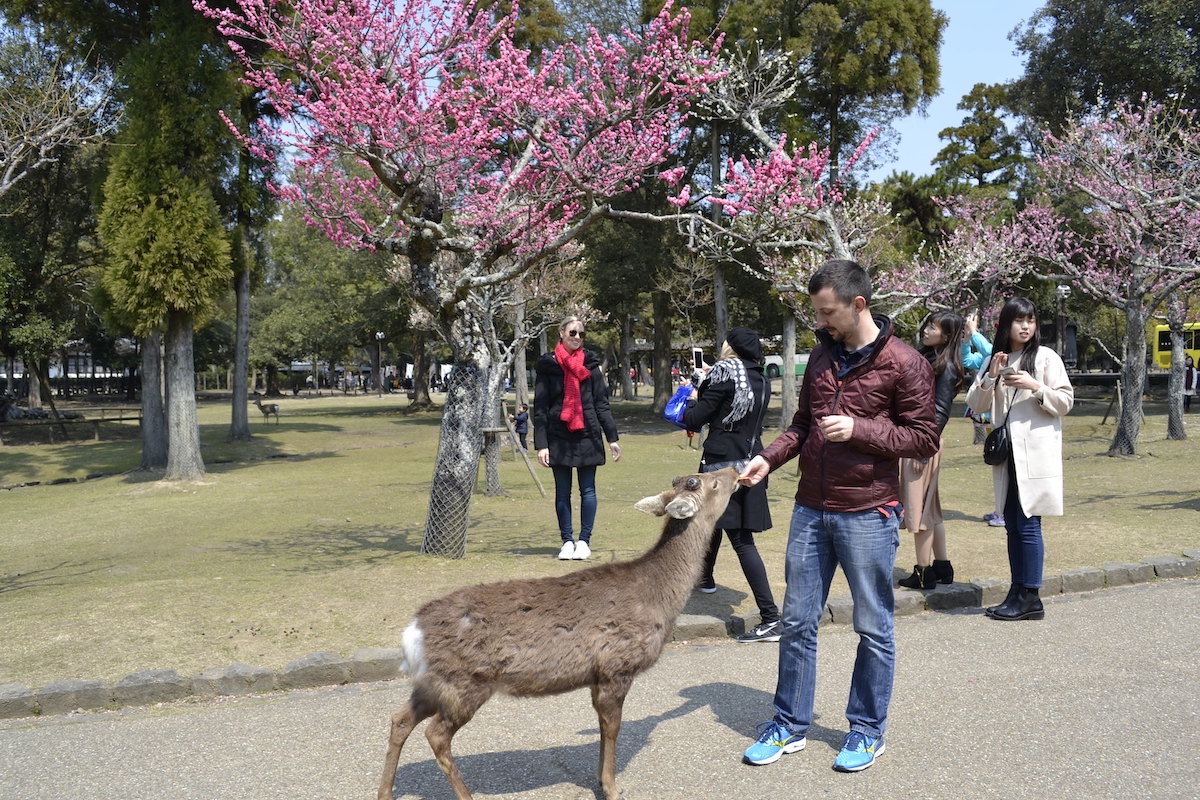
A must-stop in Nara is the Tōdai-ji Buddhist temple, which houses the largest bronze statue of Buddha in the world. We also recommend a nice walk uphill towards the Kasuga-taisha shrine, a beautiful example of Shinto architecture.

After this, we moved to Osaka for the rest of the afternoon and evening. We had dinner in the popular Dōtonbori area and we walked around the crowded shopping area of downtown Osaka. Make sure you catch the billboard of the runner crossing the finish line, it somehow become the modern symbol of the city.
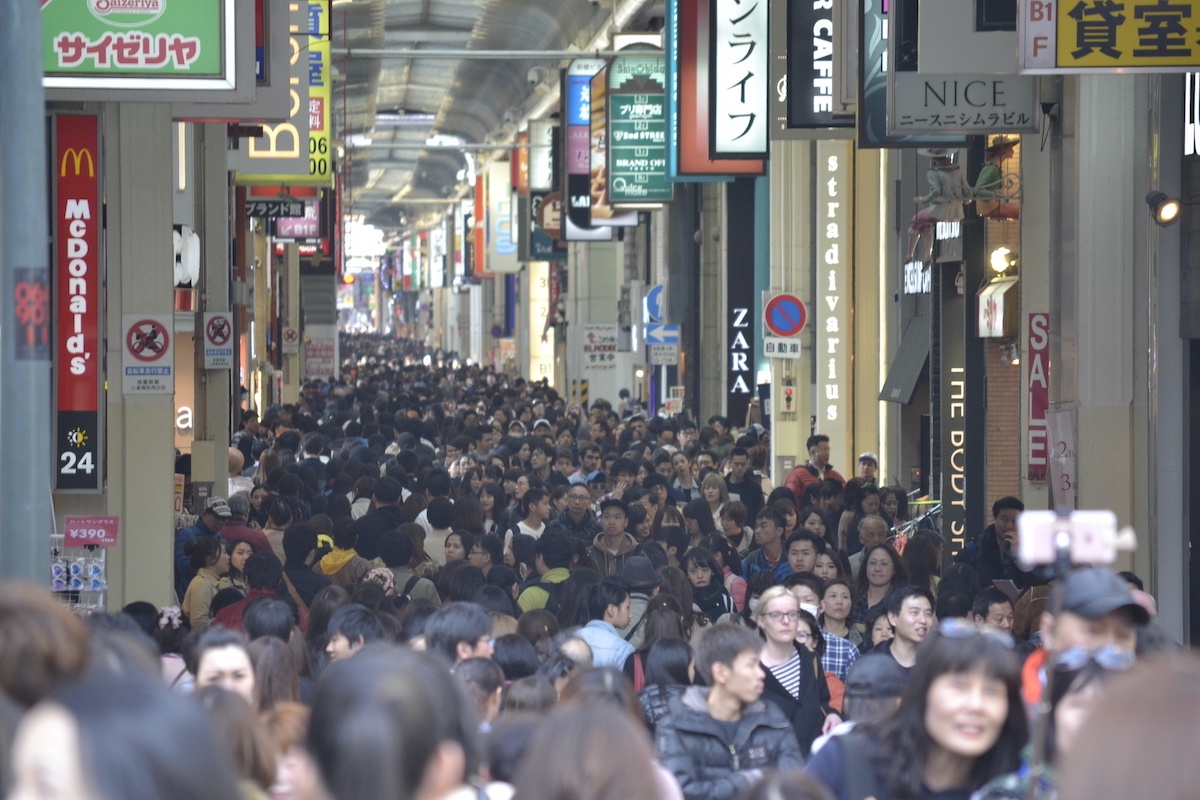
Modern Osaka resembles Tokyo, but people are proud of their city and of all the small cultural differences between it and the capital. Other popular areas in Osaka are: Namba, Umeda and Osaka Castle.
We wrapped our evening at the Umeda Sky Building, which offers a 360 panorama of the entire city from its 40th floor. Amazing views during the night! The location is also convenient, as the Umeda train station has direct connections to the neighbouring cities.

Kyoto
OK, we've been in Kansai for two days, but didn't get to visit Kyoto yet. Kyoto is famous for its temples and shrines and is pretty much an essential stop for cultural tourism in Japan.
You need around 3-4 days if you want to cover all the spots in Kyoto. Even though the city is not that big, its major attractions are spread around and public transportation is not as efficient as in Tokyo or Osaka. There are a few subway lines and also regional trains to travel outside the city.
Unfortunately, while we were there during sakura, the cherries in Kyoto were not in full bloom. Apparently, they bloomed a bit later then expected that year. Plus, the weather was not the friendliest one, so we got a bit of rain here and there. But overall, it was a great experience.
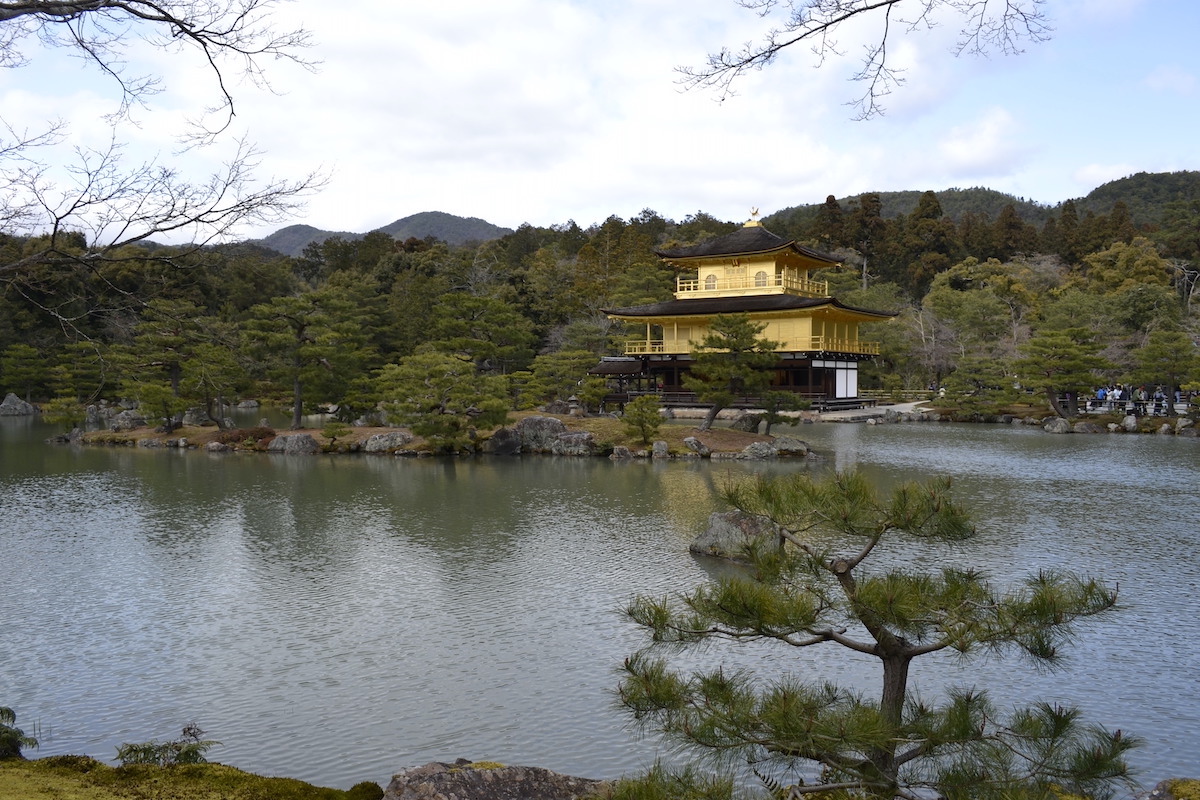
The two main religions in Japan are Buddhism and Shinto. They are both heavily represented with beautiful shrines and temples in Kyoto. The Buddhist temples have decorated gardens around them, making them popular during the high season.
Temples are recognized by the presence of Buddha statues either outside or inside the main building. Shrines are more open and don't have large closed buildings. They are impossible to miss because of the Torii gates (usually painted in bright red) that you pass under, on your way to them.
Buddhist Temples
The Golden Temple, the Silver Temple, Kiyomizu-dera and Ryōan-ji are some of the most popular spots you should not miss while in Kyoto. They are all Buddhist temples, most of them belonging to the Zen branch of Buddhism.
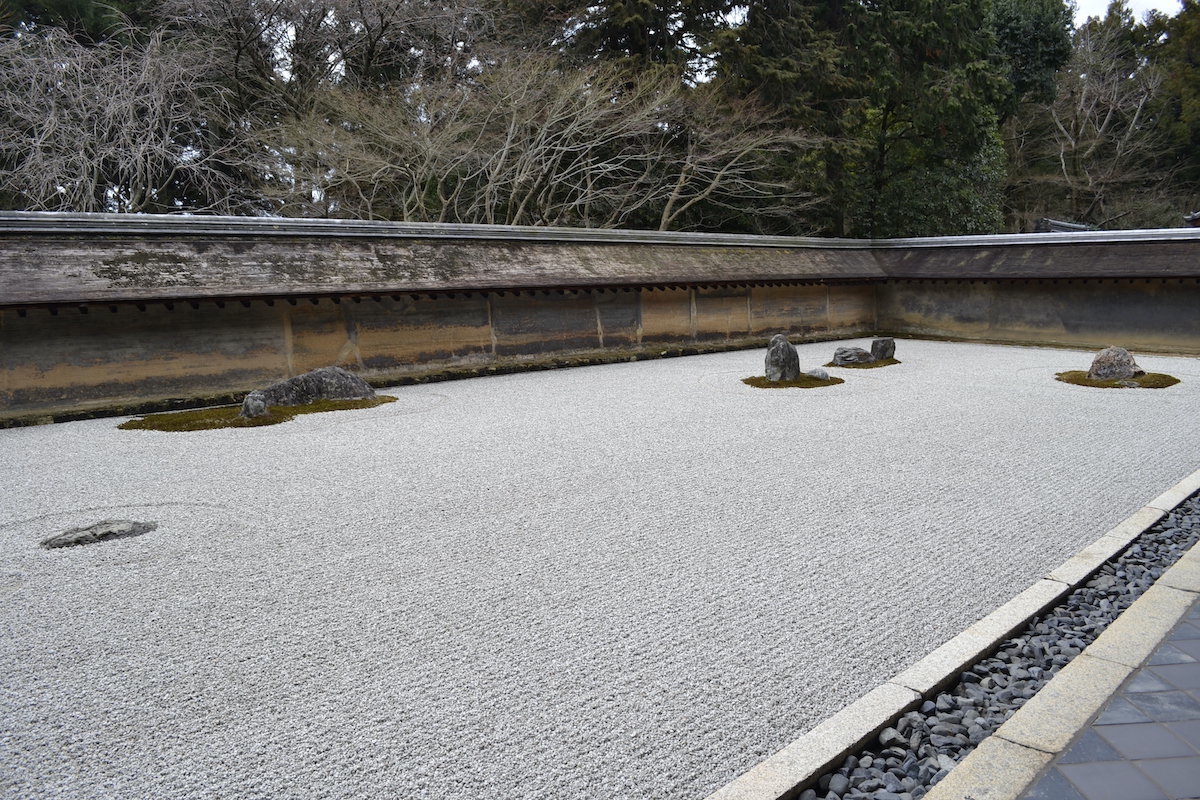
Make up your schedule so that you also have time to wander around lesser known temples. They usually offer a more relaxed and authentic visiting experience, without the crowds and the noise. For example, while visiting the Arashiyama district, we randomly stopped at Giouji Temple. It is a temple rarely found on tourist maps, and we were amazed by its beautiful garden. We're pretty sure this is not an exception, so give it a try anywhere you are.
Mount Kurama
If you spend that extra day in Kyoto, we recommend a trip outside the city, to Mount Kurama. There's a local train that takes you up north, in a heavily forested area.
Here you will find beautiful temples and shrines and a hiking trail up to Kurama-dera Temple. Going over the mountain, you can reach the Kifune Shrine, another beautiful example of Shinto architecture.
Fushimi Inari
Speaking of shrines, the most visited spot in Kyoto is the Fushimi Inari Taisha Shrine. This one is famous for its endless Torii gates that cover the pathways up and down the hill.
The entire site is super popular all day long, so expect to see a lot of people going up and down the stairs, trying to take the perfect shot though the gates. We mixed our trip to Mount Kurama with the visit to Fushimi Inari in the same day and it was a long and exhausting one! So make sure you plan enough time in between to fully enjoy it.

Arashiyama
In the western part of the city, you can find the Arashiyama bamboo forest, another very picturesque spot in Kyoto.
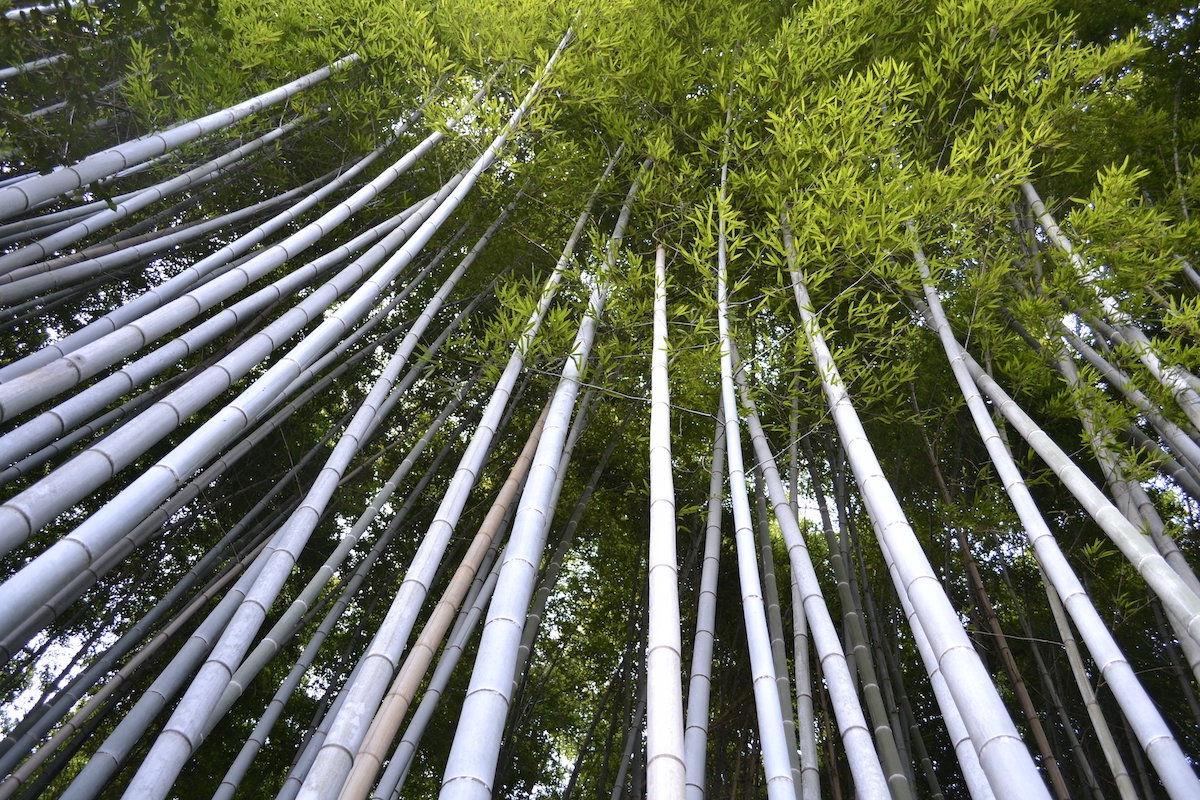
As you cross over the Katsura river, you can enter the Arashiyama Monkey Park. Situated on a hill, this site offers great views towards the city. It is also a place where you can spot the local macaques and even feed them bananas and other treats you can buy from there. But these are wild animals, so try to keep your distance and behave responsibly around them.
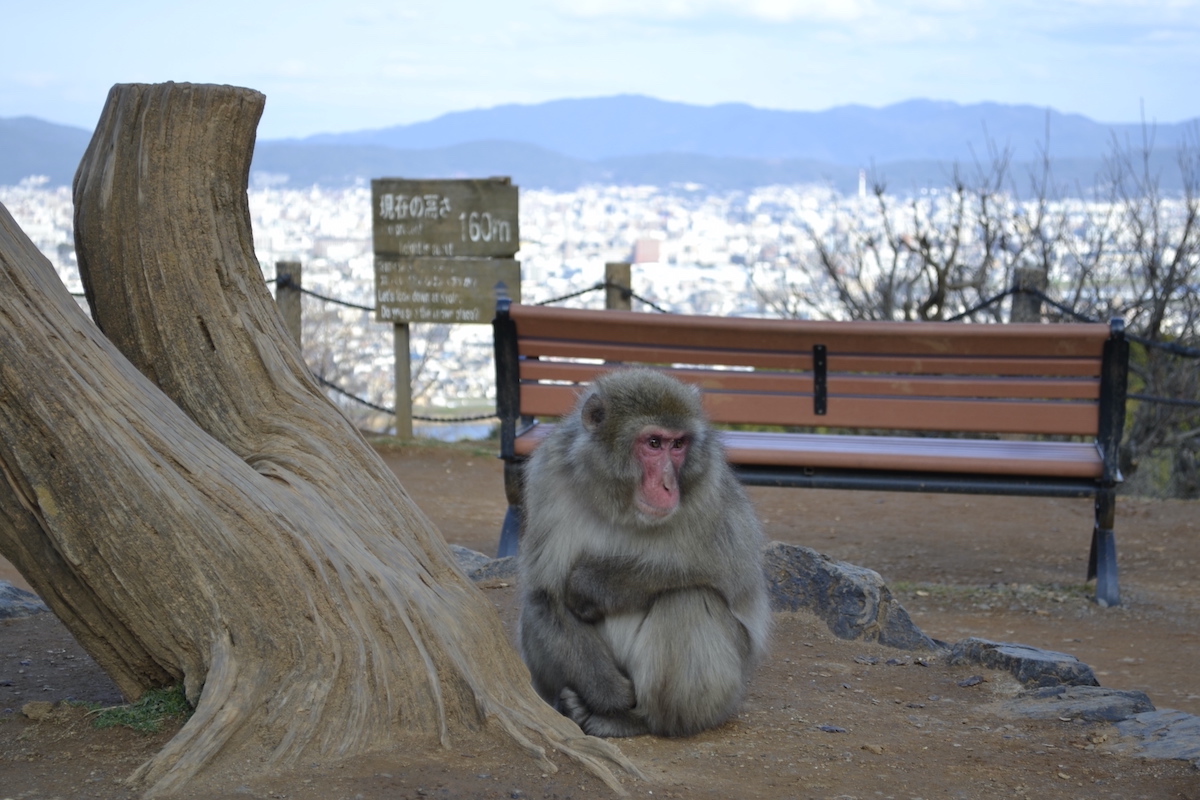
Gion
Last but not least, Gion is the famous geisha district in Kyoto. It has a unique vibe and is packed with tourists at all times. Great food in the area as well. The neighbourhood also has beautiful wooden houses, lined with craft shops.
Keep in mind that the ladies you see dressed up in the traditional kimonos are tourists, not geishas. The real geishas do not walk randomly on the streets and they are very discreet with their public appearance. You might see one sneaking towards a car or a restaurant, be respectful and avoid acting as a paparazzi. You can read more about Gion and about the difference between maikos and geikos in this official travel guide.
Days 10-13: Takayama
For the third leg of our trip, we headed towards the mountainous area of central Japan, around the town of Takayama for a different kind of experience. This is the land of traditional villages, hot springs and snowy capped mountains.
We took a direct bus from Kyoto to Takayama, as the train was significantly more expensive and required a change in Nagoya. Buses can be taken from the Kyoto train station, there's plenty of information online about different routes and options.
Takayama
Compared to everything we had experienced so far in Japan, Takayama was a different world. Small wooden houses, cozy restaurants, sake breweries and family owned businesses can be found at every step. Takayama is also famous for its beef and for its craft shops. And there's plenty of both around the town.
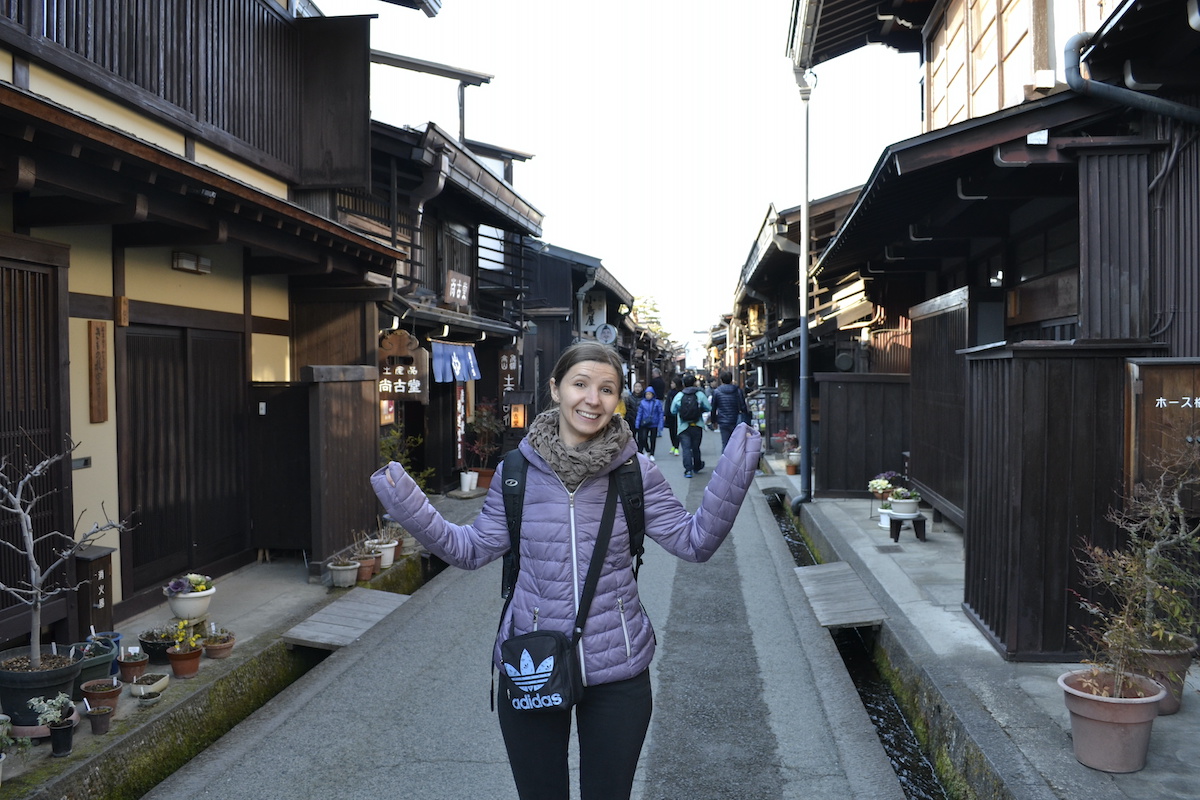
Of course, it has its share of shrines and temples, most of them open to visitors. They aren't spectacular, but they feel more authentic then the ones in Kyoto.
We spent a single day in the city, as we were really curious to experience the rural area around as well. But all in all, Takayama is a great spot to start your adventure in the mountainous area of central Japan.
Shirakawa-go
For the second day, we booked a day trip to Shirakawa-go and Gokayama, two UNESCO World Herritage villages famous for their gassho houses.
The villages are really impressive. It is definitely recommended to enter some of the houses, to understand how people used to live in Japan before the modern age.
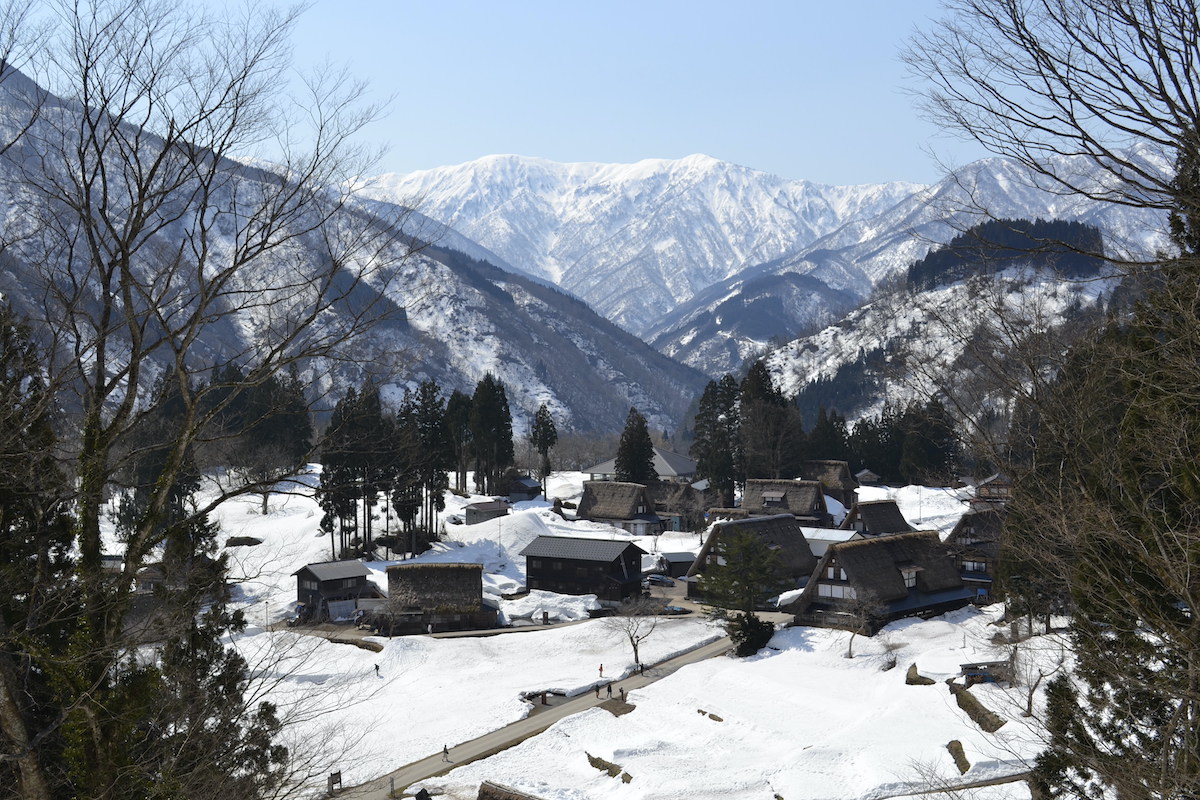
Most of the houses feature open fire places and you are usually invited to have some tea. It's a Japanese tradition to offer tea to every guest, free of charge.

We had a guide, so we were able to catch a lot of interesting facts about the villages and their history.
Okuhida Onsen
At the end of the day, we took a bus from Takayama to the heart of the mountains, in the hot springs valley called Okuhida Onsen. Most of the accommodations in this area feature their own spring baths and offer traditional rooms with futons and wooden walls. The Japanese name for such a hotel is ryokan.
We arrived here towards the end of the winter season, so there weren't that many tourists around. We had two evenings almost by ourselves at the baths. Our ryokan had both indoor and outdoor baths. The outdoor experience is amazing, especially when the air temperature outside drops below 0°C and you soak in +40°C water.
Onsens are separated by gender and there are some strict rules in place, including the fact that you are not allowed to wear any swim suit in the water.
During the day we took the local bus further up the mountain to the Shinhotaka Ropeway. This is a cable car that takes you up the mountain for some incredible views of the snowy peaks.
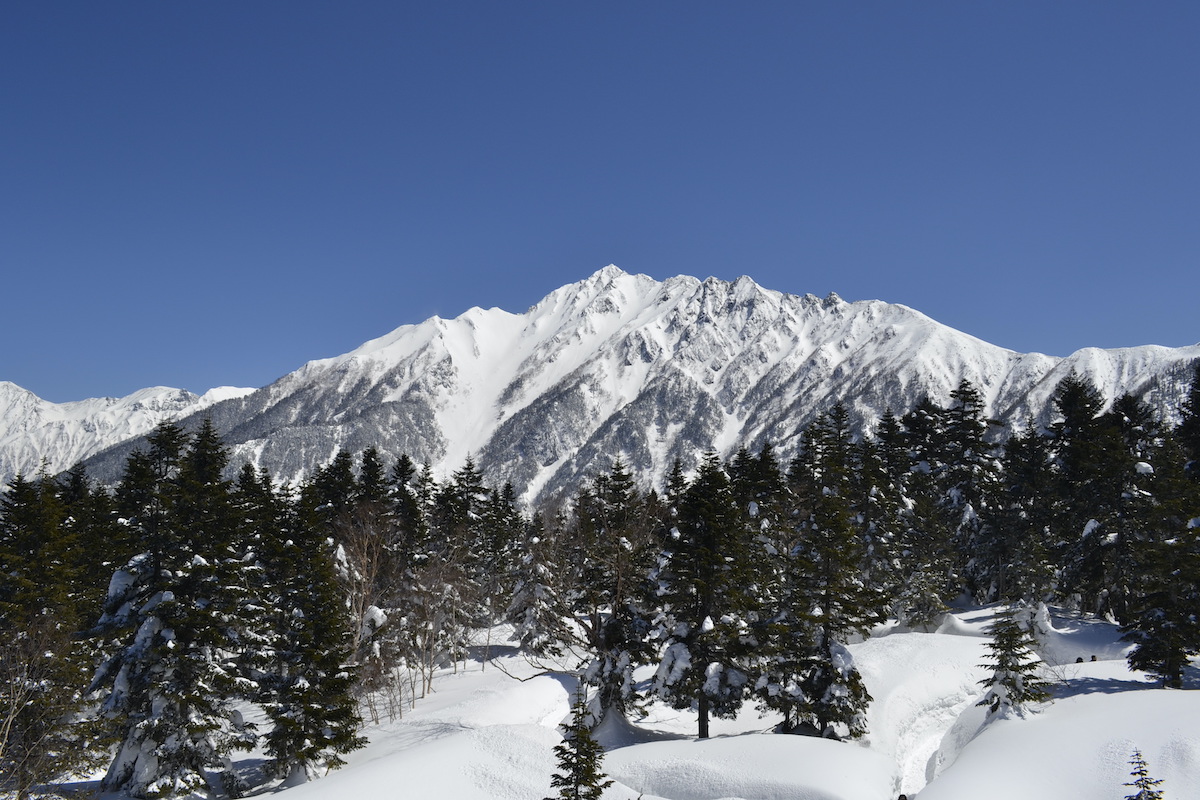
Some of the roads were still under deep snow at this time of the year. If you arrive a bit later you might find some of the high roads open, especially the famous Tateyama-Kurobe road. Whether you ride the public buses or rent a car, keep in mind that all the roads are narrow and twisty.
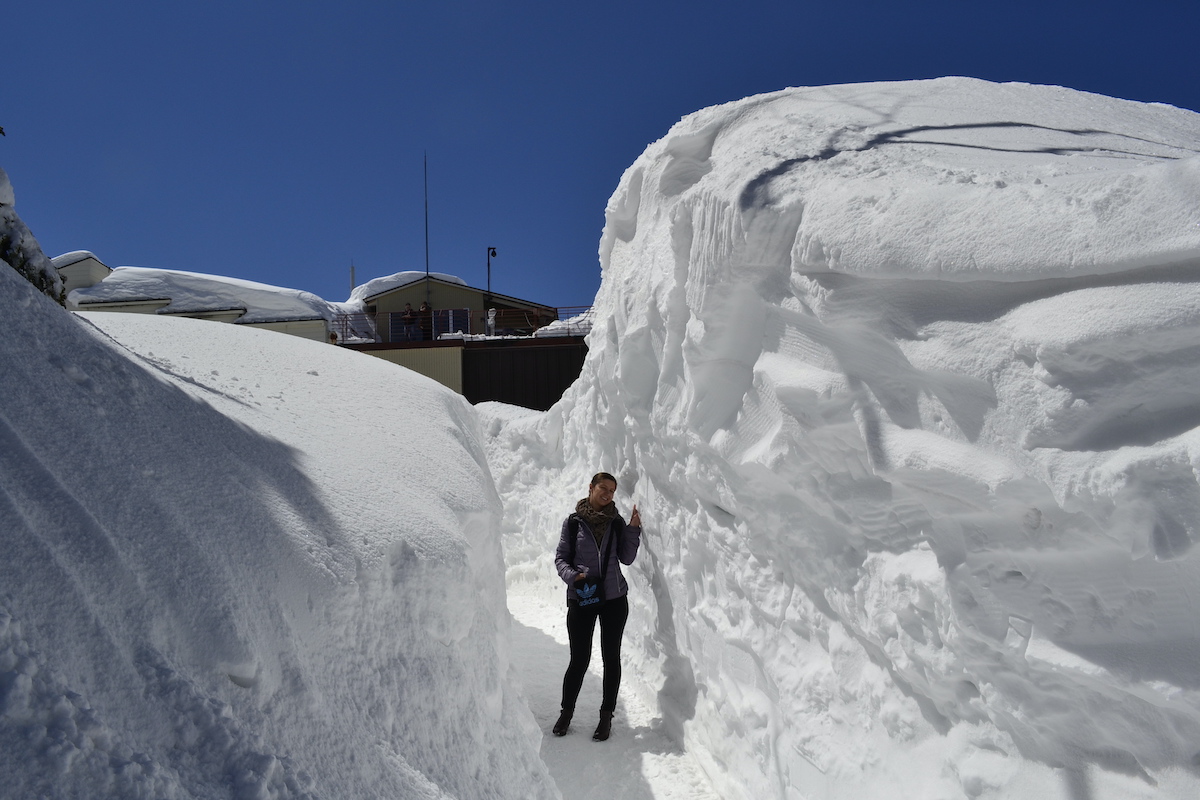
Matsumoto
The last stop in this part of Japan was Matsumoto, where we had a 3 hour break, switching the bus on our way back to Tokyo. We took advantage of the break to check out the Matsumoto Castle, one of the most picturesque castles in the entire country.
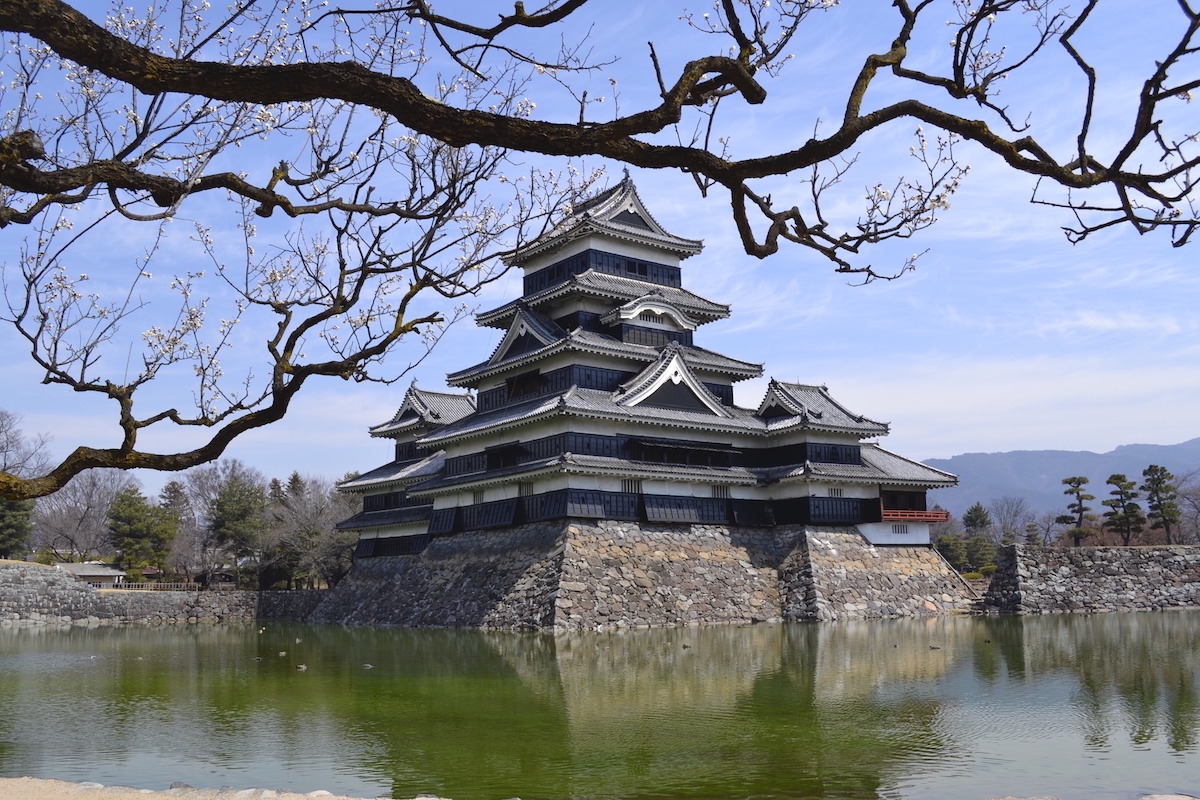
The castle is known as the "Crow Castle", due to its distinct dark exterior. It is considered one of the 3 most important traditional castles in Japan. It is surrounded by a moat and a cherry garden, so it looks stunning during the sakura. However, since Matsumoto is closer to the mountains, expect the full bloom to happen a bit later than in Tokyo.
Day 14: Tokyo
We ended our amazing two week tour with another full day in Tokyo. This time, we caught the full bloom of the sakura, so to say that the parks and streets were crowded is an understatement.
Chuo
This is the last of the main wards we visited in Tokyo. We woke up early to catch the fuss around the old fish market, Tsukiji, where we ate the best sushi ever! There are tons of small family owned places inside and around the market. Highly recommended if you're looking for an authentic experience!

From Tsukiji, you can walk for a few minutes towards Hamarikyu Gardens, another amazing park. There is a small fee you have to pay at the entrance, but totally worth it as you get a much quieter experience during the sakura.
Another area worth exploring in Chuo is Ginza, one of the big shopping areas in Tokyo, probably the most upscale one.
Meguro
After this, we did a quick detour towards Nakameguro, a long canal lined with cherries in the southern part of the city. This is one of the must-stops during sakura, but beware as it can get very crowded.
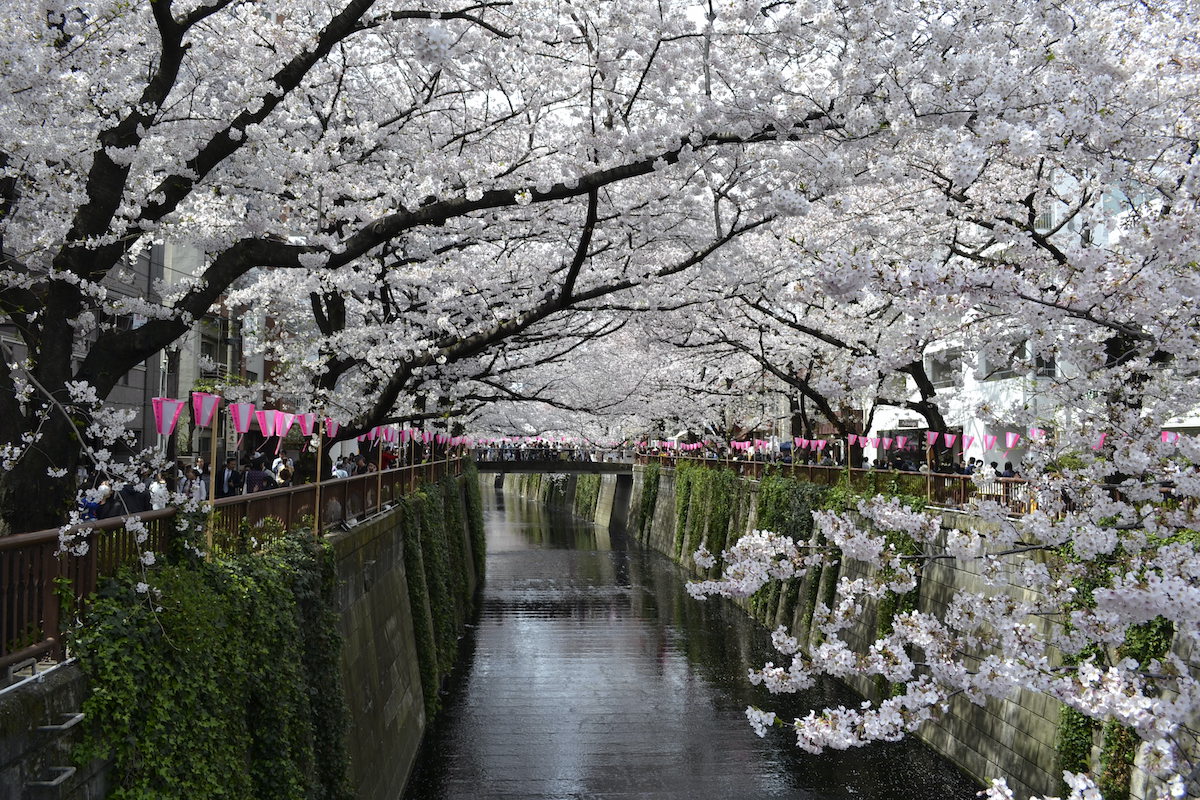
In the last part of the day we "abused" the subway passes and did a quick tour of the places we enjoyed the most during our entire visit. We had another beautiful walk in Shinjuku Gyoen and we wanted to see how the locals celebrate sakura in Ueno Park.
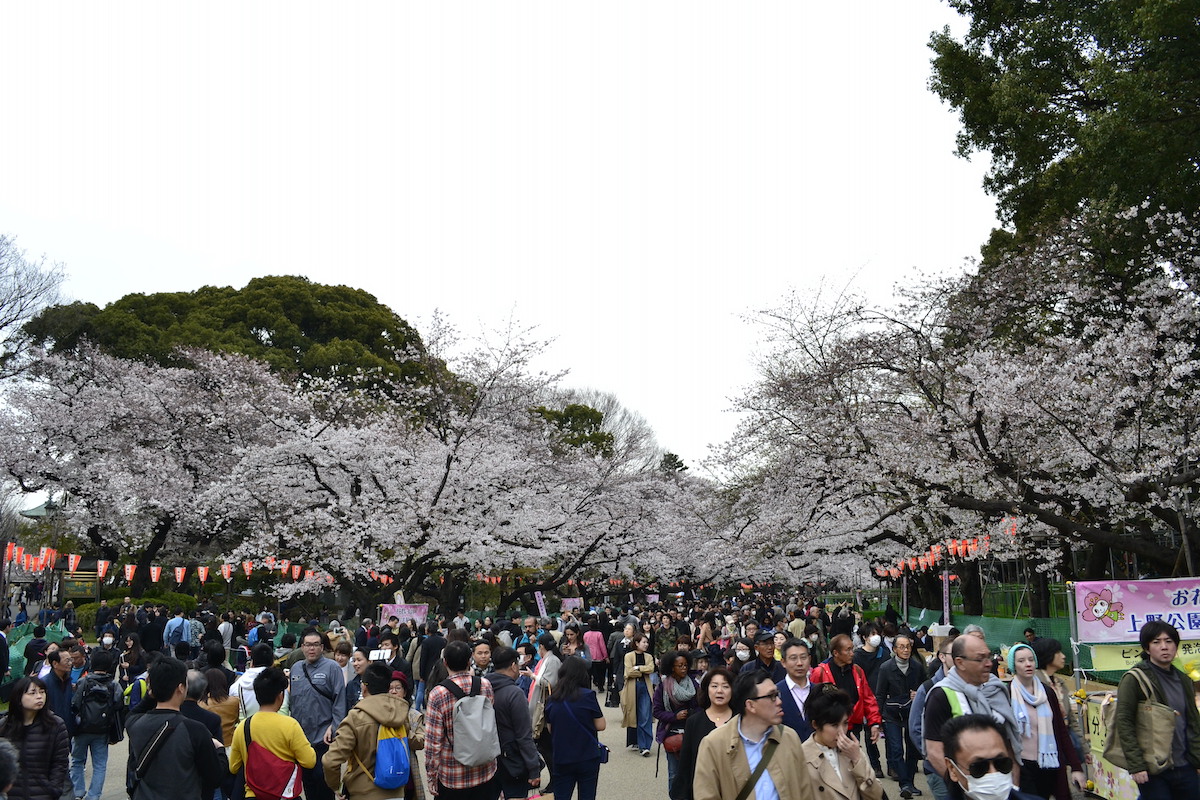
Travel tips
As we close this intense two week itinerary, we thought it makes sense to share some tips and learnings from our experience. We recommend self-documenting before arriving in Japan if you don't want to feel overwhelmed with everything.
Getting around
First off, Japan uses a Chinese-adapted character set, called kanji, but a lot of the places have a Latin letter version. So getting around is relatively easy, especially with subways and with a set of maps. However, restaurants and shops might only use the kanji writing.
One of the most useful tips we got was to rent a pocket Wi-Fi device and use it throughout the stay. It can be booked in advance and you pay the equivalent of a SIM card for the duration of your stay. We're pretty sure it would have been impossible to cover so much ground and see so many things without easy access to Wi-Fi.
We also recommend train/subway passes, bus passes, anything that can significantly cut costs for you. Public transport is quite expensive in Japan, but there are a few special offers for tourists that should not be missed.
Surprisingly few people speak fluent English, so have patience and make sure you have things written down to ease the interaction.
Culture
Japan has a distinct culture, having been isolated from the rest of the world for so many centuries. Most of the countries we visited have some traces of European influence or even feel European at their roots. But Japan is genuinely unique and different then any other country we ever visited.
One of our favorite activities was to walk and observe the people. Every activity or interaction has something distinctively Japanese in it. Even the most common things like taking the subway or entering a bar can have a totally different feel in Japan. We don't want to spoil some of the surprises, we encourage you to try to blend in and experience a unique culture.
Food
We can write a whole article about food in Japan. We, again, invite you to experiment by yourselves. There are very few restaurants and bars for tourists, so everywhere you go, you're pretty much on your own, as any local person. This can have the downside of not knowing what to order and how to eat it. But people are super friendly, especially when they see foreigners in their restaurants, so don't be afraid to ask.
Some of the famous dishes are: sushi, sashimi, tempura, udon and okonomiyaki. Beef is also amazing, cooked in various forms. Seafood is everywhere and of course you have all sorts of sweets. Also, try hitting a local izakaya pub. You will see a different face of the locals.
Money
The currency in Japan is called yen. 10000 yen is the equivalent of 78 EUR (in late 2020). One of the big surprises, for us, was that cash is king in Japan. Be ready to exchange money or withdraw from your credit cards directly. Be aware that Japanese ATMs can be confusing at first.
The prices for food and goods are similar with Western European ones. Accommodations can be on the expensive side, especially during the high season. Also, rooms are super small if you travel on a budget.
Safety
If there's one thing that stands out, is the feeling of safety you have everywhere you go. You see people leaving their bikes on the sidewalk, no locks, no safety mechanisms on. You can walk outside alone, day and night and you never feel unsafe in any way. You can leave your phone on the table and go to the bathroom in a crowded place and you will surely find it there when you come back. We never experienced this feeling of complete safety anywhere in the world.
On top of that, everywhere you go in Japan you find clean and tidy places. There's amazing attention to detail and a lot of people work in cleaning jobs, making the streets, subways, restaurants and public toilets spotless.
Sakura
The cherry blossom festival is a huge thing in Japan. The act of watching the blooming flowers is called hanami, and it is a centuries old tradition. The period of the sakura is well researched and there are several websites tracking the blossom level across the country. You can plan your trip in such a way that you catch the full bloom in different cities. But as mentioned already, it can get crowded during the full bloom days.
We hope this paints a broad picture of the traveling experience in Japan. It is impossible to capture all the amazing things that make this country a unique destination. Looking back to all our travels outside of Romania, Japan ranks among the top when it comes to the overall experience.